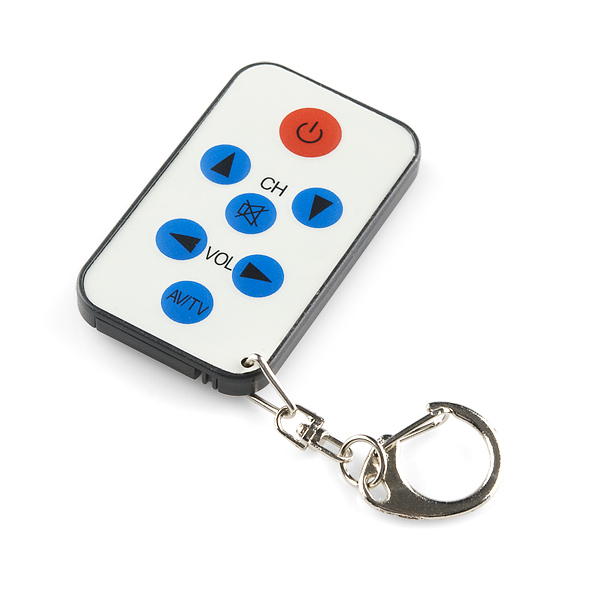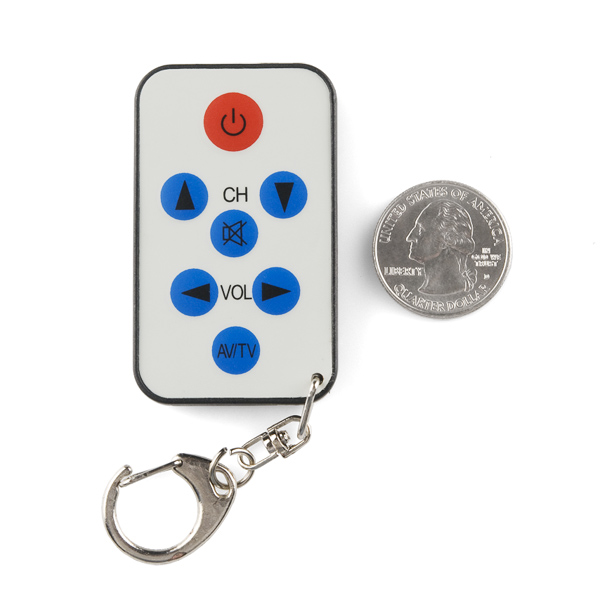Infrared Keychain Remote Control
Replacement:COM-11759. We've designed our own remote with a new color scheme and added some new buttons, go check it out! This page is for reference only.
Have you ever needed a cheap way to activate something from across the room? Infrared remotes are still the cheapest way to wirelessly control a device. We chose this remote because it's small, very simple, and low-cost. For the majority of the projects we build, we don't need 34 buttons, we need one or two. This is the smallest IR remote control we could find.
The remote does control volume, power, and mute on most of the IR equipment in our office. Unfortunately we can't guarantee that it will work with your 1995 Pioneer 5-disc CD player though. Rather, we are carrying this remote to work with many of the more common IR receiver ICs.
Check the pictures, we tore one apart so you can see what's on the inside.
Note: The unit comes with a CR2025 coin cell battery.
Note: It's come to our attention that on some (if not most) models of TV, the channel buttons on this remote will act opposite to the way they're marked. Channel up changes the channel down and vice versa. If you're using this remote with your own embedded application, this shouldn't affect anything.
Infrared Keychain Remote Control Product Help and Resources
IR Communication
February 7, 2013
This tutorial explains how common infrared (IR) communication works, as well as shows you how to set up a simple IR transmitter and receiver with an Arduino.
Comments
Looking for answers to technical questions?
We welcome your comments and suggestions below. However, if you are looking for solutions to technical questions please see our Technical Assistance page.
Customer Reviews
No reviews yet.




sniffle I loved that CD player....<br />
<br />
Just kidding, I hated those cartridges like mad.
This remote is programmable just not in the conventional sense. By holding down the mute button, the remote will send out every mute command it knows (a lot). When your TV mutes in response to the remote, let the button up and then press mute momentarily again. As a result, the remote learned the code set for your TV and the remaining buttons should work.
When the remote is first powered up, it sends several codes for each button � three NEC-standard codes (or similar) plus others. After programming, it still may send more than one code per button. The mute codes come fast during programming and there may not be enough resolution, given you reaction time, so the designers just send a few nearby codes.
To de program, leave the battery out for a while.
Thanks - my remote stopped working and it was just sending "2" to the arduino with the sketch above. I was about to order a new one when I saw this comment.
Holding down MUTE as you say while watching the arduino serial output suddenly showed MUTE pressed, and all keys work again.
I must have accidentally reprogrammed it !
The power button works in the same manner as the mute button.
Awesome! Worked exactly as you described.
Thanks Rich
Mine hasn't been "programmed" yet. I wrote a program to capture the counts of first 120-ish "Long" and "Short" pulses, as follows, where -1 is a placeholder to keep the Longs balanced with the Shorts, and -2 means "Switch to Short pulses come first after a Gap.":
Referring to the above and the other posters' comments, each button spews a consistent sequence patterns, beginning with two instances of "3Long,3Short,1L,2S,1L", followed by 5 pulses to specifiy the individual command #.
I.e., "Power" = 33121 + 5S "Mute" = 33121 + 2S,2L,1S "Channel Up" = 33121 + 2S,1L,2S "Channel Down" = 33121 + 1S,1L,3S "Volume Down" = 33121 + 1S,1L,1S,1L,1S "Volume Up" = 33121 + 3S,1L,1S "AV/TV" = 33121 + 1S,3L,1S
To summarize the above, if we assume the Short pulses represent binary-0's, and the Longs are binary-1's, then the command codes are:
Then after that it (presumably) spews out codes from other standards for the pushed button, whatever they are, they are reproducible.
Lastly, I implemented a few sanity checks to prevent fussing over clearly-malformed pulse chains:
Let me know if anyone wants to try this program with the currently-on-sale Remote.
Group for these remotes some explanation should be provided. Starting with how to get the battery holder out without destroying it. (The remote that is.) Followed by which end up the battery goes in. Battery must be put in with the plus side facing the bottom. Also instructions must be provided with the remote and the retail packaging as well.
Not working for me:( I get "-1" on every button i press. Please help. I pasted the code exacly as is :S
same here, i seems that all the buttons send more or less the same output, and none of them are understood by the code you supplied.
Sorry about that, something with the remote has obviously changed. For now, you can use the raw function in this IR Remote library.
Hi - I'd like to use this to fire a wireless relay to turn holiday lights on and off. Any recommendations on what I should get? ty
you might look at the SIS-2 IC CHIP. looks pretty straight forward from there.
Hey guys, I modified the code above so it is interrupt driven (rather than busy waiting on a single pin). Hopefully others find this useful too...
/*A simple interrupt base class to read IR input from the TSOP382 receiver diode -The user can poll "ir.available()" in their loop to see if a new key has been pressed, leaving the Arduino available for other processing
Jordan Erenrich jordan.erenrich AT gmail.com Oct 4, 2012 */
define START_BIT 2200 //Start bit threshold (Microseconds)
define BIN_1 900 //Binary 1 threshold (Microseconds)
define BIN_0 400 //Binary 0 threshold (Microseconds)
class IrReader { private: boolean resultAvail;
public: IrReader(int pin, int interruptNumber, void(*interruptCallback)( )) { this->pin = pin; pinMode(pin, INPUT);
prevVal = digitalRead(pin); bitCount = -1; resultAvail = false;
I'm new to this area. I'm looking for a simple way to use IR transmitter / receiver pair to turn a circuit on / off. It's been years since I've done circuitry / micro-processor code.
Does this use IRDA? Or is it separate?
RE: Note: Maybe if you just hold the remote upside down... no, wait. If you stand on your head... no... hmm..
Don't be silly, just put your TV upside down... um...
I set this up with my Arduino to control some high powered LEDs and it worked great. My project can't work in the living room though because this remote controls my TV as well.
I then played around with the other remotes in my house and found that they could not control the Arduino. This suggests that the universal codes are not so universal.
So I tried to teach my learning remote the signal from the key chain but it couldn't learn the signal. After I gave up on this I discovered that the key chain no longer worked on my Arduino or TV which were both getting a signal. It appears that I have reprogrammed the key chain.
This leads me to believe that one of the two IR emitters on the key chain is actually a receiver.
Sparkfun - Please give us a datasheet.
Thx Rich
Will this work with the FreeM - Infrared Controller? i'm trying to run this all to an el sequencer and some el wire for a sweater. Feedback plz
I have to make the driver for the receiver, can you send me a document with the description of the encoding used by infrared remote control.
You can also send me details on the shipment of goods
Tanks
Massimiliano Corsalini
This is the same remote that ThinkGeek carries for more $$ as the Micro Spy Remote. Go SFE!
So is this a universal remote? Does it switch between different code sets somehow or does it just send out a single, widely-recognized code set?
It's preset, so it will send out the same command every time. It cannot learn new commands.
I tested the example code and it works!
I tested it at 18 feet and it works.
BUT I only have one IR LED working out of 2! I check with a iphone and saw only one lighting.
Leave baud rate at 9600 and it works. If you try at 115200 baud you read the signal faster and get everything in double like this:
Waiting:
Key Recieved: Power
Key Recieved: Power
Key Recieved: CH Down
Key Recieved: CH Down
instead of
Waiting:
Key Recieved: Power
Key Recieved: CH Down
Have fun!
I wonder if this has to do with the remote repeating the code as you hold the button down. Maybe the slower baud rate took up more time causing the arduino to miss the next repeated incoming stream of data?
I also noticed that one LED was not blinking
I noticed the same thing. (only one led working)
But heck, it was $4 and it still works.
Say, do you suppose that perhaps the second LED is actually at a different wavelength that the iPhone can't see?
What IR wavelength does this TX at?
940nm? 950nm?
Ok I'm and EE not a mech. so that explains why I can't get the battery chamber open on the remote. Does it slide open or swing open. I just don't want to bust it.<br />
<br />
Thanks
pinch the little tab inward and then pull it out.
I knew there was a trick <br />
<br />
Thanks
Ok one more battery + faces keys of battery + faces back of remote.
Which type of coin cell battery does this use?
CR2025.
How far will this work? I know it says across a room, but could it go further?
Well that small smd transistor looks like it boosts the led output.
if you replace it with a better one or two or somehow modify it in another way you should have a bit more range.
any idea what frquency they transmit at?
Nojo, did you ever find out what frequency these transmit?
I'm gonna guess 38KHz, that seems to be the most common w/ IR.
I can confirm that this is a 38Khz remote. It works with a standard Panasonic PNA4602 receiver chip.
yes! you guys rock. I was just wishing you had these and I was this close to making cheapo version myself but this is so much simpler, I wanted to make some little IR remote control robots for x-mas presents.
...I'll just print new stickers for the front, lol